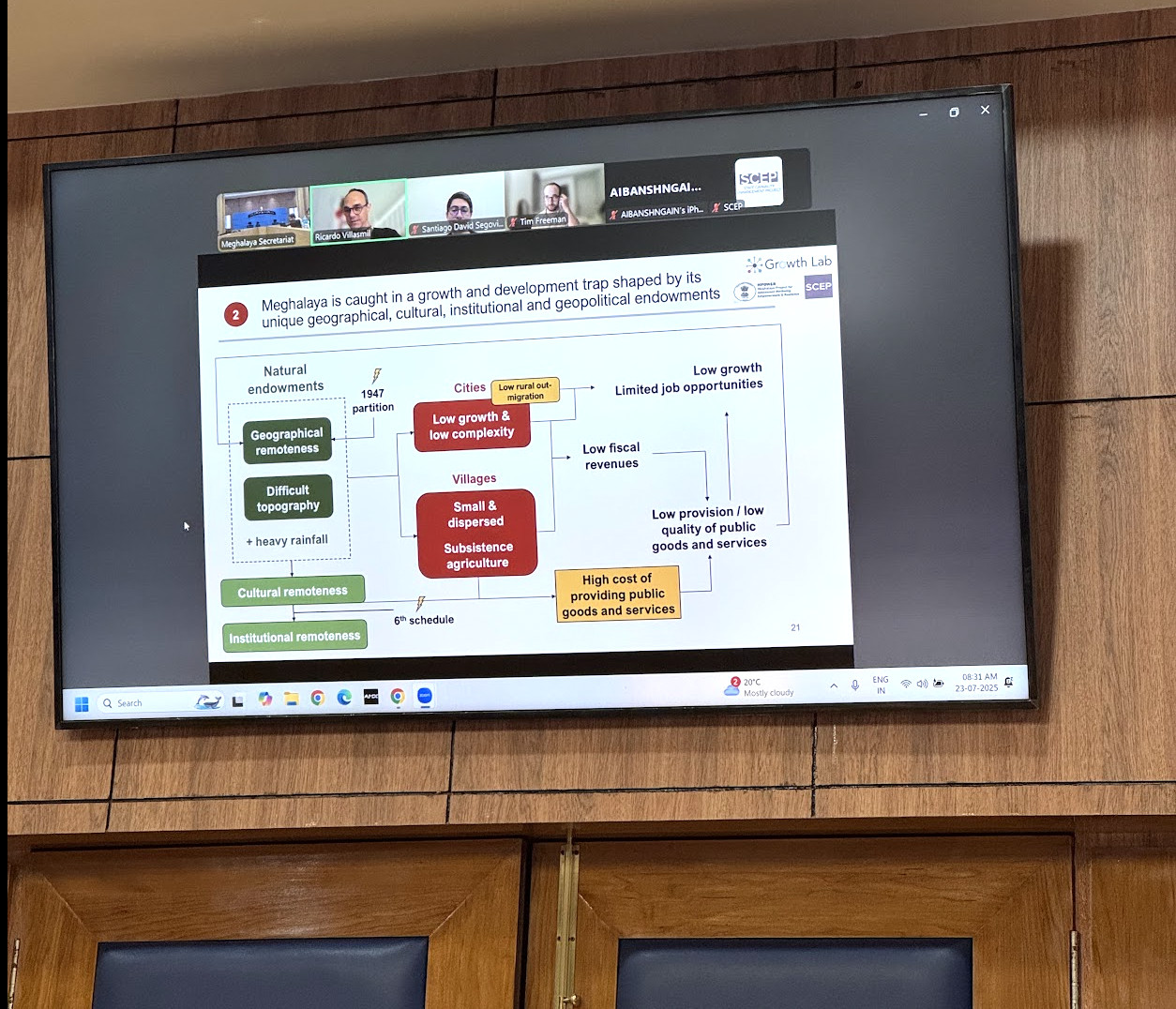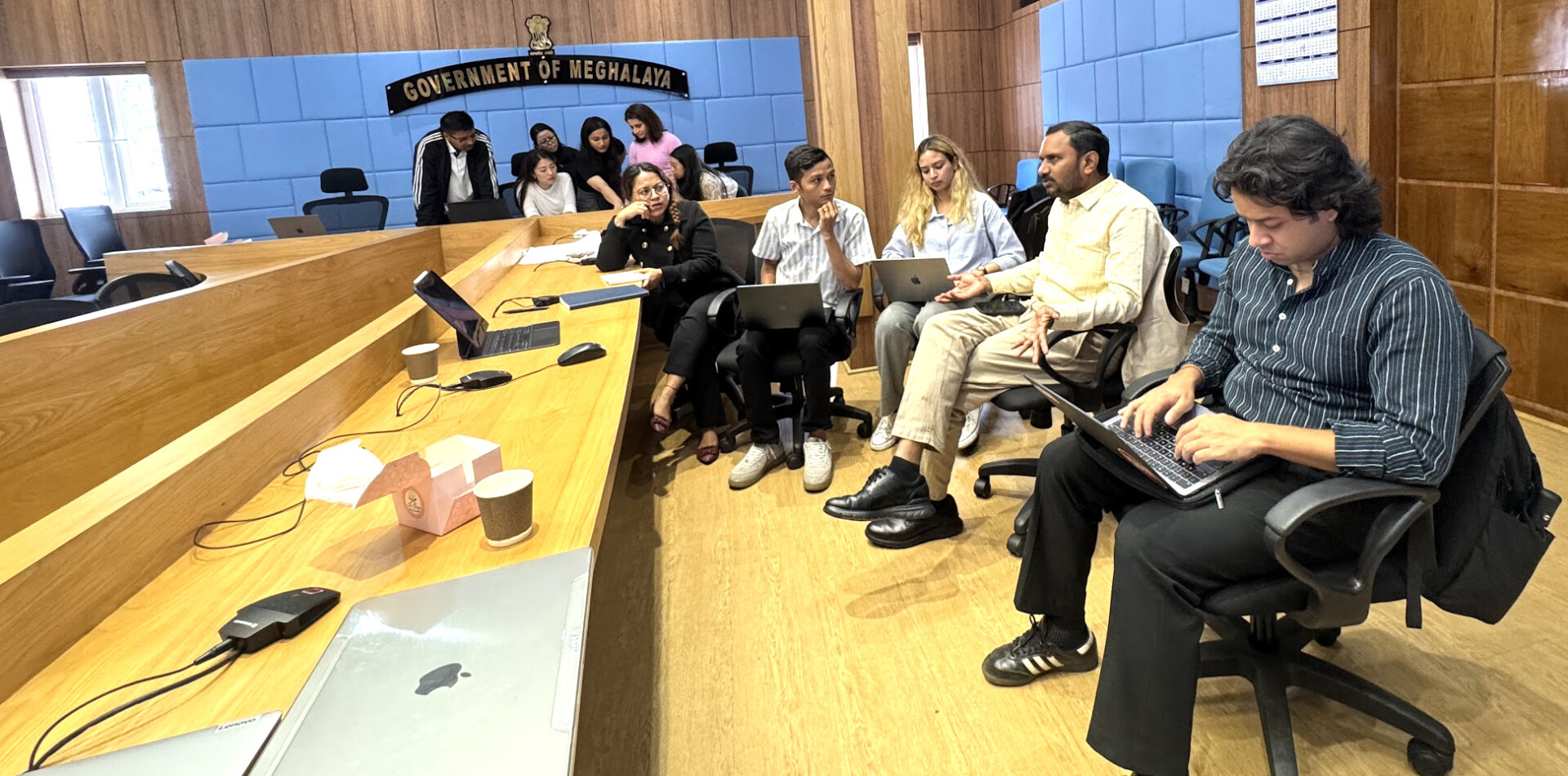Meghalaya stands at a critical juncture in its development journey. Despite progress in health, education, and infrastructure, the state continues to grapple with deep structural challenges, ranging from economic underperformance to the tensions between cultural preservation and modernization.
These themes took centre stage at the Workshop on Adaptive Leadership jointly organised by the Harvard Growth Lab and Government Innovation Lab. The session brought together state officials, development practitioners, and Harvard Growth Lab fellows Ricardo Villasmil, Senior Research Fellow; Tim Freeman, Research Fellow; and Santiago Segovia, Economic Analysis and Data Management (EADM) Fellow for a day of reflection, group exercises, and strategic thinking. The goal: to better understand Meghalaya’s unique economic and social context and explore leadership approaches that can address the challenges no single policy or technical intervention alone can solve.
Understanding Meghalaya’s Economic Context

The workshop opened with a sobering picture of the state’s economic position. Meghalaya’s per capita income is approximately 33% below the national average, and the gap is widening.
While there has been progress in some social indicators, the state’s economic structure remains dominated by subsistence agriculture, characterised by low productivity, low complexity, and limited value addition. Commercial farming remains risky due to climatic and geographic constraints, and productivity gains seen in other states have not been replicated here.
Meghalaya’s economy also faces low diversification. Alongside agriculture, small-scale mining and limited service activities make up the economic base. These sectors lack strong differentiation, making them vulnerable to external shocks.
The geography and cultural institutions of the state, its landlocked position, heavy rainfall, scattered villages, and the protections of the Sixth Schedule are both assets and constraints. They safeguard identity and traditions but also make infrastructure provision costly, fiscal revenue generation challenging, and large-scale industrialization difficult
The Policy Puzzle
The state government’s Vision 2028 has outlined pathways to support “remoteness-resilient sectors” and strengthen infrastructure, cooperatives, and investor facilitation. However, many programmes struggle to overcome deep-seated constraints that are as much cultural and political as they are economic.
One recurring theme was the clash between economic liberalism with its emphasis on open markets, private property, and industrial development and Meghalaya’s tribal land tenure systems and traditional governance. The challenge lies in finding a middle ground where economic opportunity does not erode cultural identity.
Introducing Adaptive Leadership

The Growth Lab team introduced the concept of Adaptive Leadership; a framework for distinguishing between:
-
Technical challenges, which have known solutions and can be addressed through expertise, resources, and standard processes (e.g., building a road, installing a water pump).
-
Adaptive challenges, which are rooted in values, beliefs, norms, and relationships, and require people themselves to change for solutions to take hold (e.g., shifting gender norms, negotiating land use for investment).
For Meghalaya, many of the most persistent obstacles fall into the adaptive category, where no quick technical fix exists and leadership involves mobilising people to face uncomfortable trade-offs, experiment with new ways of doing things, and learn together.
From Theory to Practice: Group Exercises
Participants were divided into groups to explore what a “Thriving Meghalaya” would look like, and what tensions might arise along the way.
Some of the key conflicts identified included:
-
Preserving tribal identity while creating economic opportunities for youth.
-
Reconciling land ownership patterns with the requirements of industrial and infrastructure projects.
-
Addressing cultural and gender norms that limit women’s full participation in economic life.
-
Overcoming language and capacity barriers to integrate local producers into wider markets.
Case Study: Ecotourism as an Adaptive Challenge
One sector was chosen for deeper analysis: ecotourism. Participants quickly saw how it contained both technical and adaptive elements.
Technical barriers included:
-
Infrastructure gaps
-
Absence of a dedicated ecotourism policy
-
Lack of investor guarantees
Adaptive barriers were more complex:
-
Land access disputes
-
Community acceptance of tourism projects
-
Coordination between local, state, and non-state actors
The discussion highlighted that without community mobilisation, trust-building, and shared ownership, even the best technical plans for ecotourism would falter.

Insights and Reflections
A recurring insight was that low engagement by the population in economic initiatives remains a serious bottleneck. While subsidies and central grants can spur activity in the short term, they are not a substitute for sustainable engines of growth that communities feel invested in.
The workshop also underscored the importance of capturing value locally. Too often, products leave Meghalaya in raw form, with most of the economic benefit captured elsewhere. Strengthening local processing, branding, and market access is crucial.
Action Points from the Workshop
The day’s discussions culminated in a set of priority actions:
-
Define a shared vision of “Thriving Meghalaya” that reconciles cultural preservation with economic dynamism.
-
Apply technical/adaptive framing to real policy problems, starting with sectors like ecotourism.
-
Improve stakeholder coordination, especially around land access processes.
-
Localise and regularly update economic and policy data for more informed decision-making.
-
Build mechanisms for continuous dialogue between state institutions and communities to bridge trust gaps.
Looking Ahead
The workshop closed on a forward-looking note. By applying the adaptive leadership framework, Meghalaya can reframe its development path not as a choice between preserving heritage and pursuing growth, but as an opportunity to integrate the two.
The next steps will involve taking this mindset into sector-specific strategies, from tourism to agriculture to youth employment, and ensuring that both technical expertise and adaptive problem-solving are embedded in every initiative.
If Meghalaya can do this, it will not only narrow its income gap but also set an example for other remote, culturally rich regions on how to thrive in the 21st century without losing their identity.